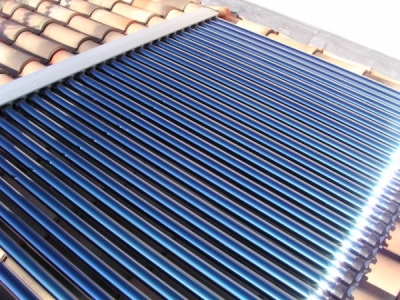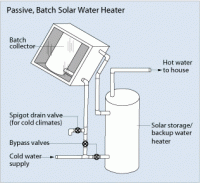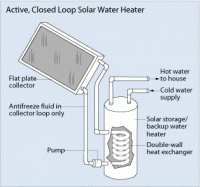You are here
Solar hot water systems generate heat from sunlight. They are also called "solar thermal" systems, though that term can also refer to solar steam turbine electricity generators. Unlike the solar heat gains from passive design strategies, solar hot water systems can pump their heat anywhere it is desired. They may look like photovoltaics, as they are usually dark rectangular installations on rooftops.
 |
Solar hot water collectors on rooftop |
Solar thermal systems are useful because they generate energy at a far lower cost than photovoltaics; however, they only generate heat, not electricity. Heat created from solar thermal systems can be used for radiant heating systems and domestic water needs.
The effectiveness of a solar water heating system is measured by its energy production per unit time per unit area, such as kWh/year•m2 or BTU/hr•ft2.
Basically, solar water-heating systems are comprised of a solar collector and a storage tank. The collector heats the water, which then flows to the storage tank. The water stays in the storage tank until it is needed for something, such as sinks or a dishwasher.
|
The simplest passive system: solar collector and storage tank. |
While many collectors simply heat water directly, cold weather can cause water to freeze and break pipes. Thus, some installations use "indirect" systems where an antifreeze fluid is heated by the sun, then brought inside the building where a heat exchanger transfers the antifreeze's heat to the water system.
Predicting Solar Thermal Energy Production
Similar to photovoltaics, the amount of energy produced by solar water heating systems depends on five main factors:
- The site conditions: latitude, longitude, and local weather
- The orientation and exposure of the solar collectors to the sun
- The efficiency of the collectors
- The available area for collectors
- The efficiency of the plumbing and storage system
Site Conditions
Site conditions are the same as photovoltaics. Determining how many kilowatts of sun energy strike the site per square meter per year will let you calculate how big and how efficient your solar thermal system will have to be to meet the building's energy needs.
System Orientation
The more directly the sun shines on solar collectors, the more energy they generate. However, it makes less of a difference for solar hot water systems than for photovoltaic systems. It is not a crucial parameter, though orienting the collectors toward the equator at a tilt equal to the site's latitude gives optimal results.
Solar collectors are usually mounted on roofs for best sun exposure.
Collector Efficiency
There are three main kinds of solar thermal collectors: the flat-plate collector, the batch collector, and evacuated tube collector. The efficiency of each depends on the local climate conditions, and can vary significantly by manufacturer. Typical collectors can have peak efficiencies from 45% - 70%.
Flat plate collectors are the most common; they tend to have the highest performance for temperate climates. They consist of a rectangular box with a transparent cover that faces the sun. Small tubes run through the box, carrying the water (or antifreeze) to be heated. The tubes are mounted on a metal absorber plate, painted black to absorb the sun's heat. The back and sides of the box are insulated to hold in the heat. Heat builds up in the collector, and as the fluid passes through the tubes, it heats up.
 |
|
Flat plate collector |
Batch collectors are essentially just tanks of water heated by the sun. They are also a water storage tank; thus, they are also called "integrated collector storage" systems. These systems are the least expensive, but only effective in hot climates where their heat loss back to the outside is not a problem.
 |
|
Water storage tanks on a roof Photo: Jeremy Faludi |
Evacuated tube collectors are like flat plate collectors, but they contain heat-absorbing water pipes in glass tubes instead of flat plates. The tubes are under vacuum to prevent heat from being conducted back out once it has been gained. These have less exposed surface area than flat plate collectors, but lose less heat, so they can be the most efficient panels for cold climates.
 |
|
Wikimedia Commons |
System Area
The area required for a solar thermal system depends on the efficiency of not just the collectors but the system as a whole. It also depends on the amount of sunlight, how intermittent the sun is, and how often backup heating systems can be used.
Solar thermal systems usually require less area than PV panels, because they are highly efficient. However, unlike PV panels, there is no equivalent of a "grid-tied" system, because hot water does not retain its heat for more than a couple days in most water tanks.
A climate that has cold cloudy winters but bright sunny summers will either need to oversize their system for the darkest times of year and have significant extra hot water during summer, or will need to size the system more moderately but use more electric or gas water heating in winter.
Plumbing and Storage Systems
The balance of a solar thermal system is the hot water storage tank, plumbing, and integration with gas or electric heaters. Systems often include additional components such as pumps, valves, temperature and pressure sensors, and an extra reservoir, for tighter control of the water temperature and quantity.
 |
| A typical system: collector and storage tank plus sensors, valves, and reservoir |
The storage tank may be any insulated water tank. Generally speaking, the larger and better-insulated the tank is, the better, for less loss of heat. Poor insulation of the tank and pipes lowers the efficiency of the system.
While a solar water-heating system can work well, it cannot heat water when the sun isn't shining--and it can be cloudy for days at a time. For that reason, buildings usually have a backup electric or gas water heater.
If the solar hot water system is integrated with electrical or gas heating, these heating systems may heat the tank that stores solar heated water, or may have their own tank, or may be on-demand systems that heat water as it is delivered to its point of use after pre-heating by the solar thermal system.
Like solar-designed buildings, solar water-heating systems can pump water actively or passively. The most common systems are active, which means they use electric pumps to move the heated water from the collector into the storage tank. Passive systems use the natural convection from temperature differences in the water to move it through the system.
  |
| Passive direct system vs. active indirect system |
The best solar hot water systems have temperature regulation, because the temperature of solar-heated water can be unpredictable--depending on the sunshine, it can be cooler or hotter than desired. It can even be dangerously hot. Temperature fluctuations are moderated by the thermal mass of the water in the storage tank, and can be managed by mixing solar-heated water with cold water, or changing the rate at which the system pumps water through the collectors.
Links and References
- Learn more about solar water heaters as well as how to choose the right one for your needs
